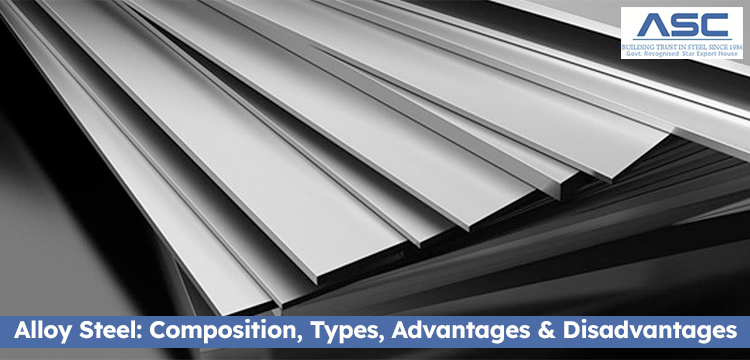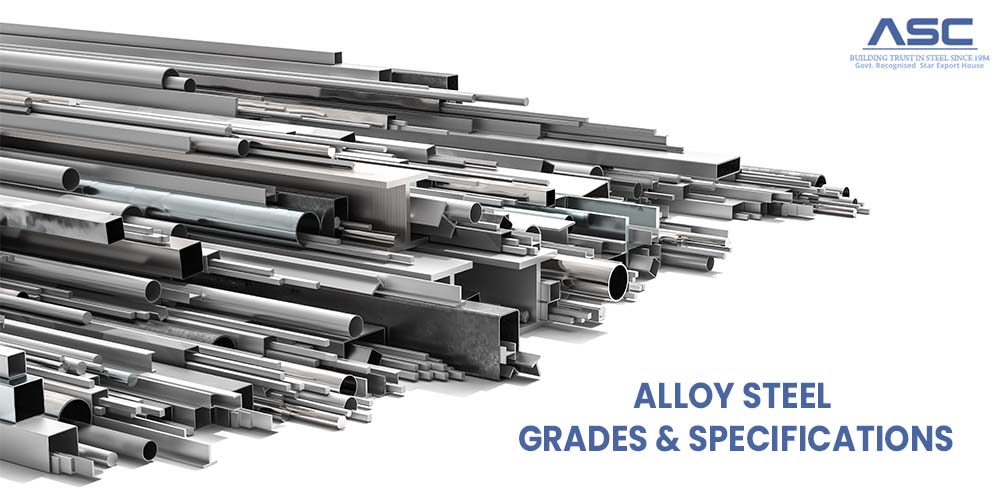Alloy Steel: Composition, Types, Advantages & Disadvantages
by AMC
Posted on May 20, 2023 at 03:29 AM

The mechanical industry relies heavily on steels, which are alloys formed by combining iron and carbon.
However, to be classified as "alloy steel," additional elements must be present. Alloy steels were developed
to enhance the metal's mechanical and physical properties, such as strength, workability, and corrosion
resistance. They offer notable benefits, including improved corrosion resistance, increased hardenability, and
superior strength in various mechanical applications.
Steels are typically divided into two main categories: high alloy and low alloy. Generally, low alloy steels
contain up to 8% alloying elements, while those exceeding 8% are classified as high alloy.
This article provides insights into alloy steel, including its classification, compositions of high alloy and
low alloy steels, manufacturing processes, and illustrative examples.
What is Alloy Steel?
Alloy steel is a specific type of steel that undergoes alloying with elements such as molybdenum, manganese,
nickel, chromium, vanadium, silicon, and boron. These alloying elements are introduced to improve the steel's
strength, hardness, wear resistance, and toughness. The amount of alloying metals can vary from 1% to 50%.
Alloy steels are classified into
two categories: low alloy steel and high alloy steel. The key distinction
between them is typically a 5% content of alloying elements. In practical terms, low alloy steel is generally
considered equivalent to alloy steel, particularly in the oil and gas sector.
Alloy steel is made by mixing iron, carbon, and other elements like chromium, nickel, and vanadium. These added elements improve its strength, durability, and resistance to corrosion. It comes in two types: low alloy steel (up to 8% added elements) and high alloy steel (more than 8%). Each type offers specific benefits, such as better toughness and hardenability, making it useful for many industries.
Find the right alloy steel for your needs at Amardeep Steel.
Alloy Steel Composition
Based on their chemical composition, steels can be categorized into three main groups: carbon steels, low-alloy steels and high-alloy steels . Alloying elements commonly found in steels include manganese, nickel, chromium, molybdenum, vanadium, silicon, and boron. During the steelmaking process, trace contaminants such as phosphorus, sulfur, manganese, silicon, and aluminum may be present due to their uptake from the blast furnace and deoxidation process in the ladle. Additionally, the use of scrap in steelmaking can introduce residuals like copper and other metals. Although these substances are not considered alloys, they typically constitute less than 1% of the overall steel composition.
Alloying Elements in Steel
The following is a compilation of commonly used alloying elements in steel, along with their associated advantages:
- Manganese :Widely utilized in steel, it reduces brittleness and the negative effects of sulphur, while enhancing hardenability and tensile strength.
- Nickel :Enhances corrosion resistance, toughness, and strength, while also improving low-temperature properties of steel.
- Chromium :Increases abrasion resistance, corrosion resistance, and hardenability. Additionally, it forms chromium carbides, contributing to steel's strength and hardness.
- Molybdenum : Improves hardenability, high-temperature strength, and resistance to wear. It also enhances the performance of other alloying elements.
- Vanadium :Boosts strength, hardness, and wear resistance in steel. It forms vanadium carbides, adding to the steel's strength and hardness.
Alloy Steel Manufacturing Processes
Manufacturing alloy steel involves
employing methods that incorporate alloying elements such as chromium,
nickel, molybdenum, vanadium, and others. Depending on the specific type and grade of steel required, diverse
processes are utilized in the production of alloy steel. Some commonly employed processes include:
Several methods are employed in the manufacturing of alloy steel, each with its unique process and feedstock
requirements:
- Electric arc furnace (EAF) process :The primary feed material, either scrap steel or direct reduced iron (DRI), is melted in an electric furnace. Alloying elements are introduced to the molten steel through oxygen blowing or vacuum degassing, followed by refining . The steel is then shaped into slabs, ingots, blooms, billets, or other desired forms.
- Basic oxygen steelmaking (BOS) process :The main feedstock consists of liquid pig iron from the blast furnace and scrap steel. Oxygen is blown into a converter, oxidizing impurities. Alloying elements are introduced and the molten steel is refined through vacuum degassing or ladle metallurgy. The steel is then formed into slabs, ingots, blooms, billets, or other shapes.
- Electric induction furnace (EIF) process :Waste steel is melted in an induction furnace using electromagnetic induction. After introducing alloying elements, the molten steel undergoes refining through ladle metallurgy. The steel is then shaped into slabs, ingots, blooms, billets, or other desired forms.
- Crucible process : Ferroalloys, steel scrap, and wrought iron are melted in an airtight crucible, using charcoal as the fuel source. The composition of the feed substance determines the carbon and alloying element content. The molten steel is then formed into ingots.
- Bessemer process : Pig iron is used as the primary feedstock, and air is blown into a pear-shaped converter to oxidize impurities. Alloying elements and carbon content can be controlled by adding ferromanganese or spiegeleisen (manganese-rich pig iron) to the molten steel. After melting, the steel is shaped into ingots.
- Open hearth process : Pig iron and waste steel are melted in a shallow hearth using gas or oil as fuel. The addition of limestone, iron ore, and other materials helps regulate the alloying and carbon content in the molten steel. The steel is then formed into ingots.
Alloy Steel Advantages & Disadvantages
Alloy Steel Advantages
Alloy steel offers several advantages over traditional carbon steel:
- Improved strength and durability :Alloy steel exhibits enhanced strength and durability, making it ideal for demanding tasks such as bridge construction or operating heavy machinery.
- Greater resilience :The presence of alloying elements in alloy steel enhances its resilience compared to standard carbon steel. It is more resistant to weather conditions, allowing for outdoor use without concerns about rust or damage caused by moisture and exposure to the elements.
- Ease of welding : Alloy steel is easier to weld compared to conventional carbon steel, simplifying fabrication processes and allowing for efficient joining of components.
Alloy steel does have several drawbacks to consider:
- Higher cost : One of the main drawbacks of alloy steel is its higher cost compared to carbon steel.
- Reduced malleability :Alloy steel is generally less malleable than carbon steel, limiting its ability to be easily shaped or formed.
- Lower melting temperature :The melting temperature of alloy steel is lower than that of carbon steel, which can affect certain manufacturing processes.
- Processing challenges : Alloy steel can be more challenging to process compared to carbon steel due to its alloying elements and different properties.
However, it is important to note that alloy steels offer excellent corrosion resistance compared to carbon steel. Examples of Alloy Steel
Alloy steel encompasses various types, including:
- Nickel Steel :This alloy steel has a high nickel content, offering exceptional strength and toughness.
- Manganese Steel :This alloy steel contains a significant amount of manganese, providing high impact strength and wear resistance.
- Chromium-Molybdenum Steel :This alloy steel incorporates chromium and molybdenum, delivering excellent strength and corrosion resistance.
FAQs
1. What is common steel alloy composition?
Common alloys include manganese (Mn) (the most common), nickel (Ni), chromium (Cr), molybdenum (Mo), vanadium (V), silicon (Si), and boron (B).
2. Is alloy steel rust-proof?
For example, carbon is mixed with iron to make steel, an alloy of iron. As strong as alloy steel is, it doesn't make it any less vulnerable to rust when exposed to the elements since it is ferrous (containing iron).
3. Which is better alloy steel or iron?
Steel is stronger than iron in the domains of yield and tensile strength, but it's also significantly tougher. For applications across various industries, steel is a superior material; it doesn't crack, warp, twist, rot, or split.
4. Is alloy better than Aluminium?
Pure aluminum, despite its many winning properties, is too soft and not strong enough for most industrial applications. However, aluminum alloys can be thirty times stronger than pure aluminum and regularly exceed steel in strength-to-weight ratios.
.jpg)
Alloy Steel vs. Stainless Steel
Alloy steel is a type of steel that is made by combining two or more different metals or elements to improve its properties.

